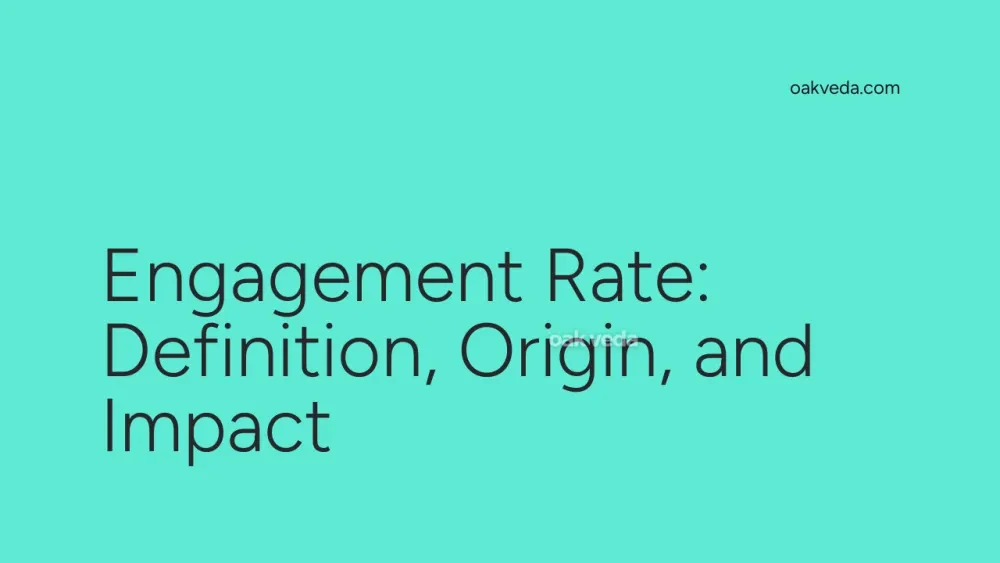
What is Engagement Rate?
Engagement rate is a vital metric in social media marketing that measures the level of interaction between users and content. It quantifies how actively and deeply audiences engage with posts, providing valuable insights into content performance and audience interest.
Origin and Development of Engagement Rate
The concept of engagement rate emerged with the rise of social media platforms in the late 2000s. As businesses began to recognize the potential of social media for marketing, they needed a way to measure the effectiveness of their efforts. Engagement rate filled this gap, offering a standardized method to evaluate content performance across different platforms and audience sizes.
How Engagement Rate Works
Engagement rate is typically calculated as a percentage, representing the ratio of total interactions to the number of people who viewed the content. The formula is:
Engagement Rate = (Total Interactions / Total Reach) x 100%
For example, if a post receives 500 likes, 100 comments, and 50 shares, and is seen by 10,000 people, the engagement rate would be:
(500 + 100 + 50) / 10,000 x 100% = 6.5%
It's important to note that different platforms may have varying definitions of what constitutes an "interaction," and some marketers prefer to use impressions instead of reach in the denominator.
Types of Engagement Rate
There are several variations of engagement rate, each serving different purposes:
- Post Engagement Rate: Measures engagement on individual posts
- Page Engagement Rate: Evaluates overall engagement across all content on a page or profile
- Reach Engagement Rate: Uses reach as the denominator (as in the example above)
- Impression Engagement Rate: Uses impressions instead of reach in the calculation
- Daily Engagement Rate: Measures engagement over a 24-hour period
Popular Examples of High Engagement Rates
Some brands and influencers consistently achieve high engagement rates:
- National Geographic on Instagram often sees engagement rates above 1%, which is impressive given their massive follower count
- Gymshark frequently achieves engagement rates of 3-5% on their fitness-related content
- Micro-influencers in niche markets can sometimes see engagement rates as high as 8-10%
Impact of Engagement Rate on Social Media Culture
Engagement rate has significantly influenced social media culture in several ways:
- Content Creation: Brands and creators now prioritize content that drives engagement, leading to more interactive and audience-centric posts
- Algorithm Changes: Many platforms use engagement as a factor in their algorithms, affecting content visibility
- Influencer Marketing: Engagement rate has become a key metric for identifying and valuing influencers
- Community Building: Higher engagement rates often correlate with stronger online communities
Controversies Surrounding Engagement Rate
While engagement rate is widely used, it's not without controversy:
- Manipulation: Some users artificially inflate their engagement through bots or engagement pods
- Quality vs. Quantity: High engagement doesn't always equate to quality interactions or conversions
- Platform Differences: Engagement norms vary across platforms, making cross-platform comparisons challenging
How Brands and Influencers Use Engagement Rate
Brands and influencers leverage engagement rate in various ways:
- Performance Tracking: Monitoring engagement rates helps evaluate content effectiveness
- Audience Insights: High-engaging content reveals audience preferences
- Influencer Selection: Brands often prioritize influencers with higher engagement rates
- Competitive Analysis: Comparing engagement rates with competitors provides valuable insights
- Algorithm Optimization: Creating highly engaging content can improve visibility on many platforms
Future Trends Related to Engagement Rate
As social media evolves, so does the concept of engagement rate:
- Weighted Engagement: Platforms may start valuing certain types of engagement more heavily
- Sentiment Analysis: Incorporating the sentiment of engagements for a more nuanced metric
- Cross-Platform Engagement: Developing standardized metrics for comparing engagement across different platforms
- AI-Driven Insights: Using artificial intelligence to provide deeper analysis of engagement patterns
- Focus on Quality: Shifting towards metrics that measure the quality of engagement, not just quantity
FAQs about Engagement Rate
-
What's a good engagement rate? It varies by platform and audience size, but generally, 1-5% is considered good, while anything above 5% is excellent.
-
How can I improve my engagement rate? Post consistently, use visuals, engage with your audience, use relevant hashtags, and create content that resonates with your target audience.
-
Does a high engagement rate guarantee success? Not necessarily. While it's a positive indicator, it should be considered alongside other metrics like conversions and brand sentiment.
-
How often should I measure engagement rate? Regularly, but the frequency depends on your posting schedule. Weekly or monthly analysis is common for most brands.
-
Can engagement rate be negative? No, engagement rate is always a positive percentage. However, very low engagement rates (close to 0%) can be considered negative in terms of performance.
Understanding and optimizing engagement rate is crucial for success in today's social media landscape. By creating content that truly resonates with your audience and encourages interaction, you can build a strong, engaged community around your brand or personal profile.
You may be interested in:
- ATP (Answer the Phone): Definition, Origin, and Impact
- Open Graph: Definition, Origin, and Impact on Social Media
- User-Generated Content (UGC): Definition, Origin, and Impact
- Simp: Definition, Origin, and Impact on Social Media
- Influencer: Definition, Origin, and Impact on Social Media
- Soft-Launch: Definition, Origin, and Impact on Social Media

